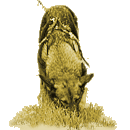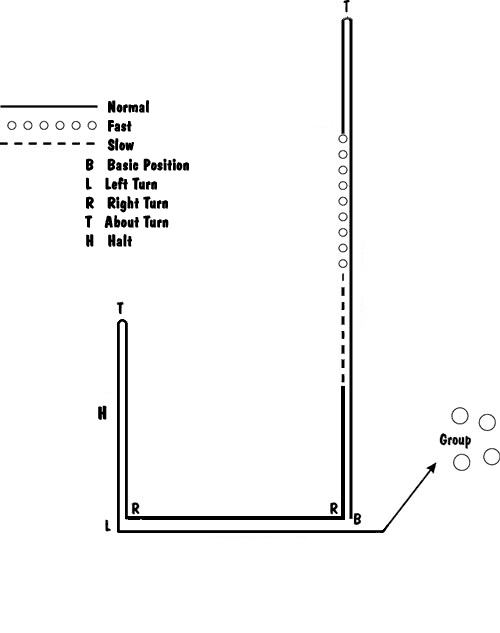... Obedience ...
After all the dogs finish tracking, the obedience takes place. The ideal field is about the size of a regulation soccer field. Two dog/handler teams report on field to the judge. One handler is instructed to place his dog in a long down and move 40 paces away and out of sight. This dog must remain in the down position without influence from the handler while the other dog completes all but the last exercise. He must remain motionless in the designated spot until picked up by the handler.
The second team begins their exercises once the first handler is out of sight. All exercises start from the basic position (dog sitting on the left of the handler his shoulder even with the handler's left leg) and are performed off leash. The handler is only permitted to use a voice command when starting the exercise or when changing pace. Hand signals are not allowed and body language is pointed as handler help. When the handler comes to a stop, the dog should come to the sit position without command. The team must be precise and spirited. The dog should perform the exercises quickly, willingly, and without extraneous handler help. Dogs that are slow to perform the exercises or show stress are pointed heavily.
The first exercise is heeling off leash (10 points). The heel pattern is described in Figure 1. During the heel pattern, as the dog and handler are moving away at least two gun shots (6-9mm) are fired; the dog must remain indifferent to the gun noise. Should the dog demonstrate gun insecurity, he is to be dismissed from the trial.
Exercise 2 (5 points): Sit Out of Motion. From the basic position, the team proceeds at least 10 paces, upon voice command the dog should sit quickly as the handler proceeds uninterrupted another 30 paces. He turns around to face the dog and wait until instructed to proceed back to the dog.
Exercise 3 (10 points): Down With Recall. Starting from the basic position, the team proceeds at least 10 paces, upon voice command the dog should down quickly as the handler proceeds uninterrupted another 30 paces. He turns around to face the dog. When requested by the judge he calls the dog to a front sit. Upon command, the dog must return to the basic position.
Exercise 4 (5 Points): Stand Out of the Walk. From the basic position, the team proceeds at least 10 paces, upon voice command, the dog should come quickly to the stand position as the handler proceeds uninterrupted another 30 paces. He turns to face the dog. When requested by the judge, he returns to the dog and commands the dog to sit.
Exercise 5 (10 points): Stand Out of the Run. From the basic position, the team proceeds at a run for at least 10 paces, upon voice command, the dog should come quickly to the stand position as the handler proceeds at an uninterrupted run another 30 paces. He turns to face the dog. When requested by the judge, he calls the dog to a front sit. Upon command, the dog must return to the basic position.
Exercise 6 (10 points): Retrieving a Dumbbell Weighing Two Kilograms (approximately 4.25 lbs) on the Flat. From the basic position and upon command, the dog should retrieve a dumbbell which has been tossed approximately 10 paces away. The dog returns with the dumbbell to a front sit. The handler commands the dog to release it, then to return to the basic position.
Exercise 7 (15 points): Retrieving a Dumbbell Weighing 650 Grams (approximately 2.5 lbs Over a Meter High Brush Hurdle. From the basic position and upon command, the dog should jump over the hurdle, retrieve the dumbbell, return over the jump with the dumbbell and come to a front sit. The handler commands the dog to release the dumbbell, then to return to the basic position.
Exercise 8 (15 points): Retrieving a Dumbbell Over the Inclined Wall (1.80 Meters High, @ six feet, and 1.50 Meter Wide at the Bottom. From the basic position and upon command, the dog should scale the incline wall, retrieve the dumbbell, return over the wall, and come to a front sit. The handler commands the dog to release the dumbbell, then to return to the basic position.
Exercise 9 (10 points): Go Ahead and Down. From the basic position, the team proceeds at least 10 paces. The dog is then commanded to "go out". The handler remains in the spot where he gave the command as the dog moves at a fast pace in the designated direction for at least 40 paces. When requested by the judge, the handler commands the dog to lay down. At the request of the judge, the handler goes to the dog and commands him to the basic position.
Exercise 10 (10 points): Long Down Under Distraction. This exercised, mentioned earlier, is completed when the handler is requested by the judge to return to his dog and commands him to the basic position.
At the
completion of both obedience exercises, the teams report to the judge and stand
for critique. The critique is detailed in nature and addressed to the audience.
The score is given at the end of each critique.
|
The
New VDH Rules, (Effective January 1 1991) standardized the obedience
heeling pattern The preferred heeling
pattern was published in Schutzhund USA in |

